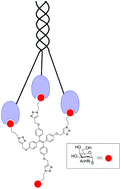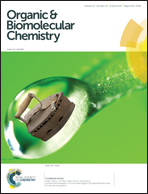Bi- to tetravalent glycoclusters presenting GlcNAc/GalNAc as inhibitors: from plant agglutinins to human macrophage galactose-type lectin (CD301) and galectins†‡
Abstract
Emerging insights into the functional spectrum of tissue lectins leads to identification of new targets for the custom-made design of potent inhibitors, providing a challenge for synthetic chemistry. The affinity and selectivity of a carbohydrate ligand for a lectin may immensely be increased by a number of approaches, which includes varying geometrical or topological features. This perspective leads to the design and synthesis of glycoclusters and their testing using assays of physiological relevance. Herein, hydroquinone, resorcinol, benzene-1,3,5-triol and tetra(4-hydroxyphenyl)ethene have been employed as scaffolds and propargyl derivatives obtained. The triazole-containing linker to the α/β-O/S-glycosides of GlcNAc/GalNAc presented on these scaffolds was generated by copper-catalysed azide–alkyne cycloaddition. This strategy was used to give a panel of nine glycoclusters with bi-, tri- and tetravalency. Maintained activity for lectin binding after conjugation was ascertained for both sugars in solid-phase assays with the plant agglutinins WGA (GlcNAc) and DBA (GalNAc). Absence of cross-reactivity excluded any carbohydrate-independent reactivity of the bivalent compounds, allowing us to proceed to further testing with a biomedically relevant lectin specific for GalNAc. Macrophage galactose(-binding C)-type lectin, involved in immune defence by dendritic cells and in virus uptake, was produced as a soluble protein without/with its α-helical coiled-coil stalk region. Binding to ligands presented on a matrix and on cell surfaces was highly susceptible to the presence of the tetravalent inhibitor derived from the tetraphenylethene-containing scaffold, and presentation of GalNAc with an α-thioglycosidic linkage proved favorable. Cross-reactivity of this glycocluster to human galectins-3 and -4, which interact with Tn-antigen-presenting mucins, was rather small. Evidently, the valency and spatial display of α-GalNAc residues is a key factor to design potent and selective inhibitors for this lectin.

- This article is part of the themed collection: In Celebration of Richard Taylor’s 65th Birthday

 Please wait while we load your content...
Please wait while we load your content...